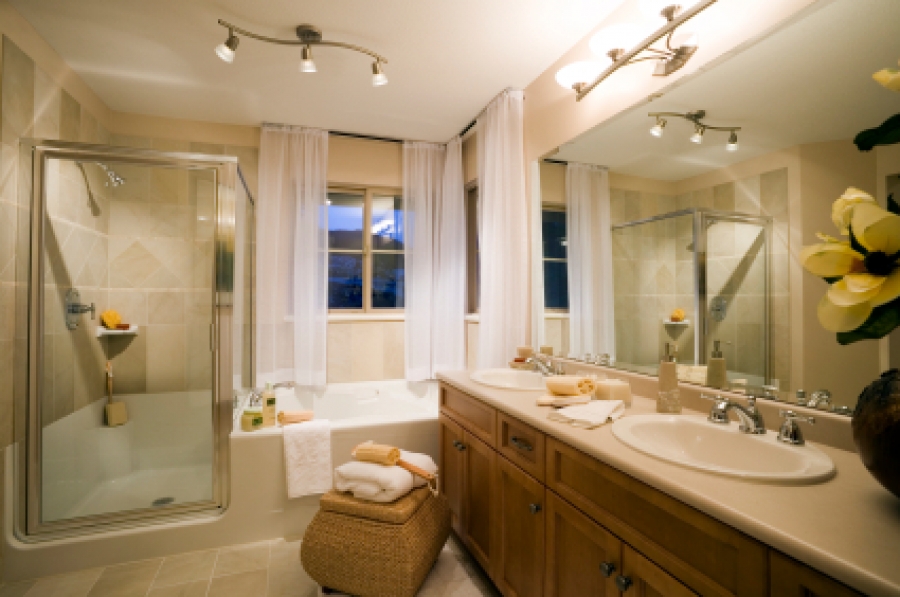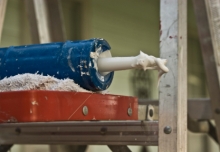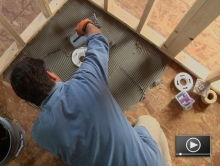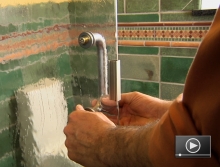Beneath Bathroom Finishes: Substrates That Manage Water and Moisture
The bathroom is one area of the home that is extremely vulnerable to water damage. Showers, tubs, toilets, and vanities provide hundreds of gallons of water on demand every day. In addition, evaporating water and steam from baths and showers significantly increase indoor humidity. Properly designed bathrooms should incorporate substrate materials under surface finishes that effectively manage water and moisture to prevent structural problems and resist mold growth.

According to the Tile Council of North America (TCNA) Handbook there are three types of areas inside the home: dry, wet, and limited water exposure.
-
Dry areas are the interior surfaces of a home that have no exposure to water and/or moisture.
-
Wet areas are interior surfaces that are frequently soaked with water, such as bathtub walls, shower walls, and floors.
-
Limited water exposure areas are interior surfaces that have no direct exposure to water but are primarily exposed to moisture in the form of humidity, such as the interior walls, floors, and ceiling of a bathroom with a tub or shower.
Dry Areas
Dry areas do not exist in bathrooms with bathtubs or showers. The interior wall and ceiling surfaces of dry areas inside a home are commonly finished by using 1/2” drywall. Drywall is a panel that is made of gypsum plaster pressed between two sheets of paper and is very susceptible to water and moisture. Drywall acts as a sponge when exposed to water, swelling and then eventually crumbling apart, losing its structural stability. The paper face of drywall is also an ideal nutrient for mold growth. When the paper face of drywall is exposed to moisture from high indoor humidity in the form of condensation, mold will eventually grow. For these reasons standard drywall is not recommend for the finished wall surfaces of a bathroom.
Wet Areas
Bathtub walls, shower walls, and the shower floor are considered wet areas inside a bathroom. These interior surfaces regularly come in contact with large amounts of water during showers and baths. In some cases your bathroom may have a bathtub or shower surround made from a nonporous material such as acrylic or fiberglass. Bathtub/shower surrounds, when properly installed and caulked, will collect and drain the water, keeping it from entering the building cavity. Wet area interior surfaces that do not have a bathtub or shower surround will commonly be finished by using natural stone or ceramic tile.
While natural stone and ceramic tile installations on the floor of wet areas are commonly installed on a sloped reinforced mortar bed over a shower pan, wall and ceiling installations can incorporate one of the many types of backer boards approved by the American National Standards Institute (ANSI) and/or the American Society for Testing and Materials (ASTM), as defined by the Tile Council of North America (TCNA) handbook:
-
Cementitious Backer Unit (CBU) panels are polymer-coated, glass fiber-meshed, Portland cement panels that are both moisture- and mold-resistant.
-
Coated Glass Mat Water-Resistant Gypsum Backer Board has a moisture-resistant core between fiberglass mats with a mold-resistant, acrylic-coated surface that retards vapor transmission.
-
Fiber-Cement Backer Boards are mold-resistant panels composed of Portland cement, additives, and/or sand, fly ash, or wood fibers.
-
Fiber-Reinforced Water-Resistant Gypsum Backer Boards are both water- and mold-resistant. They are a reinforced engineered panel that combines gypsum and cellulose fibers.
-
Cementitious Coated Foam Board is both water- and mold-resistant. These backer boards are composed of a closed-cell, extruded polystyrene foam board that is covered with fiberglass mesh and a cement coating.
In addition to backer boards, the installation of natural stone or ceramic tile in wet areas may incorporate a waterproof membrane. Waterproof membranes are available in either sheet or liquid form. When used in conjunction with an appropriate hard-surfaced substrate, waterproof membranes will protect the structure from water damage. Types of waterproof membranes include:
-
Elastomeric fabric embedded into a thinset mortar,
-
Elastomeric fabric bonded by using a proprietary adhesive,
-
Reinforced fabric over self-curing liquid rubber polymer,
-
Fiberglass mesh over self-curing liquid rubber polymer,
-
Liquid rubber polymer,
-
Liquid acrylic, and
-
Liquid urethane.
A custom tiled bathtub and/or shower should have a vapor barrier installed between the backer board and the wall cavity to prevent the transmission of water vapors into the wall cavity. A vapor barrier of 6-mm (or "6 mil") polyurethane plastic sheeting or like material may be an integral feature of backer board. It is imperative that seams, gaps, and rips be taped to prevent the passage of moisture. Vapor barriers have the potential to be problematic if the exterior wall cavity is not properly constructed to allow the exterior wall to breathe as it should. The transmission of water vapor to the inside or outside along the exterior walls of your home depends on your climate, hot or cold. Ensure that you understand the building code requirements for your locality as they relate to vapor barriers prior to installation.
Limited Water Exposure Areas
Floors
The interior floors in limited water exposure areas inside a bathroom are commonly finished by using vinyl flooring, natural stone, or ceramic tile. Vinyl flooring materials are impervious and waterproof. Sheet or tile vinyl products are generally installed over plywood or another rigid substrate. Generally speaking, properly installed vinyl tiles will provide enough water resistance to protect the structure below. However, if you desire a watertight installation, tiles should be laid by using heat or should have solvent-welded joints.
Natural stone and ceramic tile floor installations in limited water exposure areas can incorporate one of the aforementioned types of backer boards approved by the American National Standards Institute (ANSI) and/or the American Society for Testing and Materials (ASTM).
In addition to backer boards used under floor finishes, the installation of natural stone or ceramic tile on floors in limited water exposure areas may incorporate a relatively new material known as an uncoupling membrane. An uncoupling membrane is a thin, polyethylene sheet that has a geometric grid structure and an anchoring fleece. The anchoring fleece, found on the bottom side of the membrane, is embedded in thinset mortar over the top of the subfloor. The geometric grid structure reacts to movement, allowing the subfloor and finished floor to move independently of one another. Uncoupling membranes are made of a waterproof material that has air channels to support the evaporation of moisture within the substrate.
Walls and Ceiling
The interior walls in limited water exposure areas inside a bathroom are normally finished with natural stone, ceramic tile, paint, or wallpaper. Natural stone and ceramic tile wall installations in limited water exposure areas should be installed over moisture-resistant drywall. Painted walls and ceilings and/or wallpapered surfaces in limited water exposure areas should be finished over textured and skim-coated, moisture- and mold-resistant drywall. Moisture- and mold-resistant drywall is essentially standard drywall with additives to the core that increase water resistance; the paper faces of such drywall have either been treated to resist mold or replaced with fiberglass mats.
In conclusion, it is important to note that whether you are planning a new build or remodeling an existing bathroom, mechanically ventilating the excess humidity from baths and showers to the outdoors is necessary, whatever the properties of the substrates used. As you would when selecting any building material, you should consult with the product manufacturer(s) prior to selecting drywall, backer board, or membrane for the wet and limited water exposure areas of your bathroom. These materials are available in a variety of sizes and thicknesses and have varying application requirements and attributes. By referring to the manufacturer’s recommendations and installation instructions, you’ll ensure that any needs specific to your chosen materials and their application are properly met.

Jeff Calcamuggio
Jeff is an Editor-at-Large for Buildipedia.com who writes and edits Featured At Home and Knowledgebase content. Prior to joining Buildipedia, Jeff's work experience included carpentry, construction documentation, specification writing, construction administration, project management, and real estate property inspection. Jeff is a member of the Construction Specifications Institute (CSI) and an educator at Columbus State Community College and enjoys challenging DIY home improvement projects.




